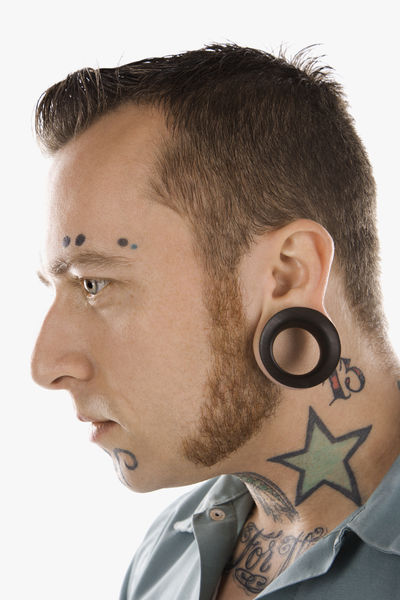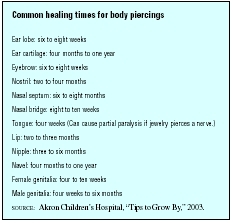Piercing and tattoos

Definition
Body piercing and tattoos are forms of body art that have been practiced throughout history by various cultures.
Purpose
Tattoos and body piercing are done as expressions of independence, for religious or cultural reasons, or to adorn one's body. Tattooing is accomplished by injecting pigment into the deeper layers of the skin, usually by way of needles or air pressure.
Piercing is performed quickly and without anesthesia by either a spring-loaded ear-piercing gun or piercing needles, with the needle diameter varying from six to 18 gauge. The skin is cleaned, and then the needle and jewelry are inserted through the tissue in one swift motion. Piercing is typically completed in tattoo or beauty parlors.
Description
Various cultures have embraced adorning the human body with piercings and tattoos throughout history. In 1992, the 4,000-year-old body of a tattooed man was discovered in a glacier on the Austrian border, and historical research has shown that Egyptians identified tattooing with fertility and nobility in the period from

In industrialized cultures in the early 2000s, tattoos and piercing have become a popular art form enjoyed by people of all ages. They also are indicative of a psychology of self-mutilation , defiance, independence, and belonging, as for example in prison or gang cultures.
Popular piercing sites include the ear, nasal septum, eyebrow, tongue, cheek, nipple, navel, labia, and penis. Tattoos permanently mark various areas on the body.
Originating from the Tahitian word tattau , meaning "to mark," tattoos are relatively permanent marks or designs on the skin. An electric needle injects colored pigment into small, deep holes made in the skin to form the tattoo. Prison tattoo techniques are usually very crude, in marked contrast to the highly skilled art practiced in Japan and also performed in the United States and in Europe. In the early 2000s, the ancient art of Mehndi, or temporary tattooing of the skin with a paste made of henna has become popular in the United States and around the world. Henna is a stain normally made for hair and, therefore, exempt from U.S. Food and Drug Administration regulation. Although seemingly safe because it does not pierce the skin, henna tattoos using black henna, a paste that contains parahenylenediamine, can actually be dangerous when absorbed into the skin of some people.
Risks
While piercing and tattooing are popular, both present distinct health risks. Tattoos can lead to the transmission of infectious diseases, such as hepatitis B and C and theoretically HIV, when proper sterilization and safety procedures are not followed. Black henna tattoos can cause significant allergies and rashes , leading to renal (kidney) failure and even death in those who are sensitive to their ingredients. These types of tattoos have appeared particularly dangerous to young children. Body piercing also presents the risk of chronic infection, scarring, hepatitis B and C, tetanus , and skin allergies to the jewelry that is used. One study reported that 17 percent of college students with piercings suffered a medical complication such as infection or tearing. Use of piercing guns and preferences for upper ear piercing have led to increased infections. The force of the gun's delivery further complicates matters around the delicate cartilage of the upper ear and some people require surgical intervention.
Body piercing and tattooing are unregulated in most parts of the United States, and illegal in some. The American Dental Association opposes oral (tongue, lip, or cheek) piercing, and the American Academy of Dermatology is against all forms of body piercing except ear lobe piercing.
Some of the signs of an infection from either piercing or tattoos are obvious, such as inflammation of the pierced or tattooed area, while the symptoms of hepatitis C, the most common blood-borne infection in the United States, may not be so obvious. Allergic responses to tattoos may occur due to the pigment compounds used, such as oxides of iron, mercury, chromium, cadmium, and cobalt and synthetic organic dyes. Symptoms of an allergic reaction include swelling, redness, and severe itching . The symptom of henna tattoo reaction is an eczema-like rash around the tattoo site. The patch should be tested for reaction severity before it proceeds to anaphylactic shock or severe allergic reaction.
Most infections from piercing are due to the use of non-sterile techniques. The skin pathogens streptococcus and staphylococcus are most frequently involved in skin infections from piercing. The fleshy tissue around the pierced area may weaken and tear, leading for example, to a badly disfigured earlobe. Other common complications include contact dermatitis and scars. Piercing can result in endocarditis (inflammation of the heart), urethral rupture (when the labia is pierced), and a serious infection of the penis foreskin (when the foreskin is pierced) leading to severe disability or even, on rare occasions, death.
Normal results
Though painful initially, many tattoos and piercings heal well, do not become infected, and are satisfying to the wearer. Those interested in getting a tattoo or piercing should look for an established business with clean facilities. Equipment should be sterilized between uses, and the person applying the tattoo or piercing should wear clean latex gloves. The skin should be cleaned and an antiseptic applied to minimize the risk of infection. Common problems are infection, which can range in severity from mild to severe, and deciding that a particular tattoo or piercing is unsatisfactory. Piercings can close on their own if allowed to heal naturally shortly after the piercing is done. If done too late, the hole may close incompletely or not at all. Tongue piercings are among the most likely to become infected and often cause tooth damage.
Treatment of a local infection from piercing includes warm compresses and antibacterial ointment for local infections to a five-day course of oral antibiotic therapy. If hepatitis B or C is confirmed, a series of diet and lifestyle changes, such as the elimination of alcohol, is recommended to control the disease.
There are five methods to remove tattoos when desired, including using a laser to break up tattoo pigments; surgical removal that involves cutting the tattoo away; sanding the skin with a wire brush to remove the epidermis and dermis layers in a process called dermabrasion; using a salt solution to soak the tattooed skin (salabrasion); and scarification, removing the tattoo with an acid solution to form a scar in its place. Topical steroids can often treat reactions to henna tattoos, but improvement may take several weeks.
Depending on the type of infection resulting from either piercing or tattoos, the treatment and prognosis vary. Minor infections respond well to antibiotic therapy, while blood-borne diseases such as hepatitis B and C cause life-altering results. Disfigurement may or may not be fully correctable by later plastic surgery. People particularly sensitive or allergic to the ingredients in

| SOURCE : Akron Children's Hospital, "Tips to Grow By," 2003. |
| Ear lobe: six to eight weeks |
| Ear cartilage: four months to one year |
| Eyebrow: six to eight weeks |
| Nostril: two to four months |
| Nasal septum: six to eight months |
| Nasal bridge: eight to ten weeks |
| Tongue: four weeks (Can cause partial paralysis if jewelry pierces a nerve.) |
| Lip: two to three months |
| Nipple: three to six months |
| Navel: four months to one year |
| Female genitalia: four to ten weeks |
| Male genitalia: four weeks to six months |
black henna may suffer serious consequences, even death, if their reaction progresses. Others may be left with scarring or altered pigmentation along the tattoo design.
Parental concerns
Obviously, the best way to prevent infection from piercing or tattoos is not to get one in the first place. However, the risks can be minimized. Procedures should be performed in a sterile environment by an experienced professional. The person performing the procedure should remove a new needle from the plastic in front of the person to be tattooed and should put on a new pair of sterile gloves. Anyone considering a henna tattoo should require proof from the artist that he or she is using pure, safe brown henna, not the unsafe black henna.
Piercing should be completed with smoothly polished jewelry made of 14 or 18 carat gold, titanium, surgical steel, or niobium. An allergic reaction can result with the use of jewelry made of brass plate or containing a nickel alloy. Healing time from a piercing ranges from six months to two years. A piercing should be completed in a sterile environment that uses every precaution to reduce the risk of infection. Excessive force, such as exerting a strong pull, should never be applied to jewelry inserted into pierced body parts to avoid tearing and injuring tissues.
KEY TERMS
Endocarditis —Inflammation of the inner membrane lining of the heart and/or of the heart valves caused by infection.
Hepatitis —An inflammation of the liver, with accompanying liver cell damage or cell death, caused most frequently by viral infection, but also by certain drugs, chemicals, or poisons. May be either acute (of limited duration) or chronic (continuing). Symptoms include jaundice, nausea, vomiting, loss of appetite, tenderness in the right upper abdomen, aching muscles, and joint pain. In severe cases, liver failure may result.
Socialization —The process by which new members of a social group are integrated in the group.
Resources
BOOKS
Mason, Paul. Body Piercing and Tattooing. London: Heinemann, 2003.
Whittington, Christine, and Kathlyn Gay. Body Marks: Tattooing, Piercing, and Scarification. Brookfield, CT: Millbrook Press, 2002.
Winkler, Kathleen. Tattooing and Body Piercing: Understanding the Risks. Berkeley Heights, NJ: Enslow Publishers, 2002.
PERIODICALS
Amatuzio, J. "The meaning of the mark: the fascinating forensic aspects of tattoos." Minnesota Medicine 87, no. 3 (2004): 22–5.
Armstrong, M. L., et al. "Contemporary college students and body piercing." Journal of Adolescent Health 35, no. 1 (2004): 58–61.
Dunn, W. J., and T. E. Reeves. "Tongue piercing: case report and ethical overview." General Dentistry 52, no. 3 (2004): 244–7.
Gunter, T. E., and B. M. McDowell. "Body piercing: issues in adolescent health." Journal for Specialists in Pediatric Nursing 9, no. 2 (2004): 67–9.
ORGANIZATIONS
American Academy of Dermatology. 930 N. Meacham Road, PO Box 4014, Schaumburg, IL 60168–4014. Web site: http://www.aad.org/.
American Academy of Family Physicians. 11400 Tomahawk Creek Parkway, Leawood, KS 66211–2672. Web site: http://www.aafp.org/.
American Academy of Pediatrics. 141 Northwest Point Boulevard, Elk Grove Village, IL 60007–1098. Web site: http://www.aap.org/default.htm.
American College of Physicians. 190 N Independence Mall West, Philadelphia, PA 19106–1572. Web site: http://www.acponline.org/.
WEB SITES
"How Tattoos Work." How Stuff Works. Available online at http://science.howstuffworks.com/tattoo.htm (accessed November 2, 2004).
"Tattoos and Permanent Makeup." U.S. Food and Drug Administration. Available online at http://vm.cfsan.fda.gov/dms/cos-204.html (accessed November 2, 2004).
"Tattoos, Piercings, and Body Markings." National Geographic. Available online at http://www.nationalgeographic.com/tattoos/ (accessed November 2, 2004).
L. Fleming Fallon, Jr., MD, DrPH
Ear cartilage: four months to one year
Eyebrow: six to eight weeks
Nostril: two to four months
Nasal septum: six to eight months
Nasal bridge: eight to ten weeks
Tongue: four weeks (Can cause partial paralysis if jewelry pierces a nerve.)
Lip: two to three months
Nipple: three to six months
Navel: four months to one year
Female genitalia: four to ten weeks
Male genitalia: four weeks to six months
i dont know what type of research yeah have done on this but alot of these are wrong as hell. for ex. lip two to three months thats not right it about two weeks to a month. Nasal septum: six to eight months wrong maybe four weeks to 2 months at the least. come on research this stuff better ask your local tattoo shops. they will know better then this SOURCE: Akron Children's Hospital, "Tips to Grow By," 2003